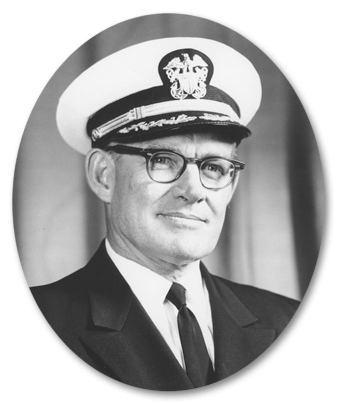Ship's Crew

Albert C. Messier
Rank(s): Lieutenant
Dates of Service: 4/30/1952 - 6/22/1954
Birth Date: 8/11/1917
Death Date: 9/14/1981
Albert Clarence Messier was born in Bristol, Connecticut on August 11, 1917. After attending public schools, he enlisted in the navy in 1938 and, from August of that year until June 1940, he served in the light cruiser Concord on Neutrality Patrol in the Atlantic. He then transferred to the small seaplane tender Heron (AVP-2), a converted World War I minesweeper serving in the Asiatic Fleet. In the Dutch East Indies at the outbreak of World War II, the small craft was repeatedly attacked by Japanese aircraft trying to sink the vessel with bombs and torpedoes. Though damaged, Heron fought her way clear and made it to Australia. Messier was wounded in the affair and awarded a Purple Heart; the ship was awarded a Navy Unit Commendation. For the next two years, Heron operated in Australian waters. On February 29, 1944, Messier was commissioned an ensign and served as navigator on the seaplane tenders San Carlos (AVP-51) and Gardners Bay (AVP-39). Both were active in the invasion of the Philippines in October 1944 and again successfully fought off Japanese attackers. Promoted to lieutenant junior grade in 1945, Messier ended the war on the destroyer tender Dixie (AD-14) serving in the Far East. In 1946, he was in charge of motor gunboat PGM-29, one of the smallest units supporting the atomic bomb test at Bikini Atoll. That September, Messier left the service, though he had a change of heart and returned to the navy in December 1946 as a chief quartermaster. From then until January 1948, he served in the minehunter AMCU-10 and the destroyer minesweeper Gherardi (DMS-30) in the Atlantic Fleet. He headed a navy recruiting office from May 1948 to July 1950. His commission was restored on July 20, 1950, and he served as assistant navigator on the escort aircraft carrier Sitkoh Bay (CVE-86), which was employed in carrying military aircraft from the West Coast to various commands in East Asia.
Messier took command of Constitution on April 30, 1952. He also commanded the 1854 corvette Constellation, moored just across the pier from “Old Ironsides,” which served as quarters for his crew. The following April saw the first Easter sunrise service held aboard Constitution for the ship’s company and civilians. Messier also oversaw the replacement of rotten hull planking. He was promoted to lieutenant on July 29, 1953.
Leaving “Old Ironsides” on June 22, 1954, Messier next commanded the net layer Hazel (AN-29) in the Canal Zone and then the fleet tug Nipmuc (ATF-157) on the East Coast. Promoted to lieutenant commander on October 1, 1958, he came ashore in May 1959 as Base Security Officer at Naval Station, Newport, Rhode Island. He returned to sea duty in May 1961 in command of the salvage ship Escape (ARS-6). Promoted to commander on August 1, 1963, Messier concluded his career as executive officer of the destroyer tender Arcadia (AD-23), beginning in January 1964. He retired to his home in Connecticut at the end of that tour and died there on September 14, 1981.